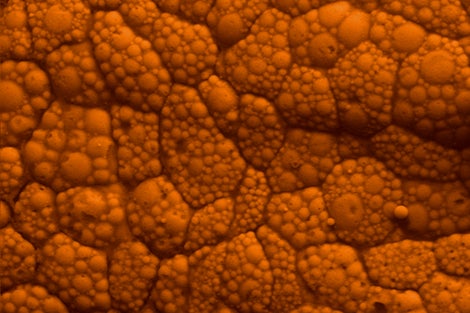March 12, 2018 – About a decade ago, scientists dispelled the widely held belief that brown fat is only present in newborns and infants by discovering that it persisted in adults. It also turned out that the very small amount of brown fat that remains in grown-ups plays a major role in keeping the body’s metabolic system running smoothly. This has made brown fat a potential target for new drugs to treat diseases where the metabolic system malfunctions, such as obesity and diabetes.
In a new study, a team of researchers at Harvard T.H. Chan School of Public Health made a major advance in our understanding of how brown fat cells work. They discovered a molecular switch that turns certain vital processes inside the cells on and off to support the functions of protecting the brown adipose tissue. In a series of experiments, the scientists used the switch to improve the metabolic health of mice with symptoms of obesity and diabetes.
“It’s a tremendously promising finding,” said senior author Gökhan S. Hotamisligil, J.S. Simmons Professor of Genetics and Metabolism and head of the Sabri Ülker Center for Nutrient, Genetic and Metabolic Research. “If we can understand these mechanisms fully, we can turn the switch on and off in brown fat cells to help people with metabolic problems.”
The study was published online February 5, 2018, in Nature Medicine.
Two kinds of fat
There are two major kinds of fat in the body, white and brown. White fat is much more prevalent. It’s what builds up in the waist and thighs when you become overweight.
Brown fat gets its color from the chestnut hue of its mitochondria, a component of the fat’s cellular powerhouse machinery. Brown fat is much more scarce than white fat. In newborns, it makes up just 0.1 percent of body weight. In adults, there can be as little as 0.001 percent, most of it hidden deep inside the tissue in the back of the neck and along the spine.
Despite its rarity, brown fat has many vital biological functions. It consumes a tremendous amount of nutrients from the blood and it keeps us warm. Through a process called thermogenesis, the brown fat cells burn calories to generate heat.
It’s an extremely fuel-intensive process. Once activated, brown adipose tissue can use up to half the sugar and fat in circulation, remarkable given how little brown fat humans have. There is great hope that this capacity of brown adipose tissue could be exploited for therapeutic purposes, said Hotamisligil.
But there’s a drawback to this heightened activity — a build-up of waste byproducts in the form of ubiquitinated or damaged and malfunctioning proteins. “There must be an efficient disposal system that protects the tissue from this buildup of toxic materials,” he said.
It turns out that brown fat cells are unique in how much and how quickly the trash starts piling up. And unless it’s cleared, the cells will malfunction, damaging the body’s metabolic systems and causing disease.
Toggling the on-and-off switch
The researchers discovered that in brown fat, this disposal system consisted of a cylindrical-shaped complex of proteins called proteasomes. The proteasomes function like a grinder in a sink disposal unit, breaking up the waste into bits and pieces. The scientists also identified the switch that activates this process, a molecule called Nrf1, short for nuclear factor erythroid-2, like-1.
Nrf1 is located in the endoplasmic reticulum (ER), a network of membranes that extends throughout the cell’s interior, excluding the inside of the nucleus. Brown fat cells start working to warm us when they sense outside cold weather.
The researchers observed that the Nrf1-proteasome pathway was stimulated by cold as well. “We were very surprised and excited to see this,” said Alexander Bartelt, who co-led the study with Scott Widenmaier while they were postdoctoral research fellows in the Department of Molecular Metabolism and the Sabri Ülker Center.
After making these initial discoveries, the Harvard team ran a series of experiments involving the Nrf1 molecule in mice with symptoms of obesity and diabetes. Bartelt, Widenmaier and colleagues eliminated production of Nrf1 in the mice, specifically in the brown adipose tissue, so there was effectively no longer a switch to turn the brown fat cells’ waste disposal system on. The animals’s brown fat became inflamed, lost its brown properties and malfunctioned, resulting in systemic metabolic disease.
The scientists also developed a system for delivering extra Nrf1 into the brown adipose tissue of obese mice, the equivalent of keeping the switch in the on position for longer than normal. This markedly improved the systemic metabolic health of obese and diabetic animals, which have defects in Nrf1 and proteasome activity. Importantly, the team also found Nrf1 at high levels in human brown fat tissue samples, supporting that Nrf1 plays a key role in humans as well as in mice.
In future experiments, Bartelt, now a principal investigator at the Ludwig-Maximilians-University of Munich, said he and his Harvard Chan colleagues will break apart Nrf1 for further analysis in order to see if it can be exploited for therapeutic purposes. It’s a challenge to develop drugs that seek out and find molecules located on the ER, but Nrf1 offers a large menu of possibilities, he said. By identifying the molecular components of Nrf1 regulation, the researchers may be able to pinpoint easier targets for a medicine to engage.
photo courtesy Alexander Bartelt
